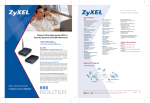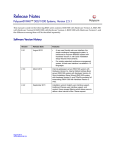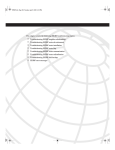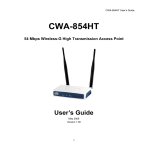Download ZyXEL Communications 662HW Network Router User Manual
Transcript
Prestige 662HW Series
802.11g Wireless ADSL 2+ 4 Port Security Gateway
Compact Guide
Version 3.40
May 2004
Prestige 662HW Series Compact Guide
Table of Contents
1 Introducing the Prestige..............................................................................................3
2 Hardware .....................................................................................................................4
2.1 Rear Panel Connections.........................................................................................4
2.2 The Front Panel LEDs ...........................................................................................5
3 Internet Access With Zero Configration ...................................................................7
4 Setting Up Your Computer’s IP Address ..................................................................8
4.1 Windows 95/98/Me.................................................................................................8
4.2 Windows 2000/NT/XP ..........................................................................................11
4.3 Checking/Updating Your Computer’s IP Address................................................12
4.4 Testing the Connection to the Prestige.................................................................12
5 Configuring Your Prestige........................................................................................13
5.1 Accessing Your Prestige Via Web Configurator ..................................................13
5.2 Common Screen Command Buttons .....................................................................15
5.3 Internet Access Using the Wizard ........................................................................15
5.4 Test Your Internet Connection .............................................................................21
6 Advanced Configuration...........................................................................................21
6.1 Wireless LAN Setup..............................................................................................21
6.2 Wireless LAN Security Setup................................................................................24
6.3 802.1x and WPA Overview...................................................................................26
6.4 Network Address Translation Overview...............................................................26
6.5 Configuring SUA Server ......................................................................................27
6.6 Firewall Overview................................................................................................29
6.7 Enabling the Firewall with Default Policy...........................................................30
6.8 Procedure for Configuring Firewall Rules ..........................................................31
7 Troubleshooting.........................................................................................................38
2
Prestige 662HW Series Compact Guide
1 Introducing the Prestige
The Prestige 662HW ADSL 2/2+ Gateway with 802.11g Wireless is the ideal all-in-one
device for small networks connecting to the Internet via ADSL. Key features of the
Prestige include NAT, 802.1x wireless LAN security, WPA (Wi-Fi Protected Access),
firewall and anti virus packet scan. See your User’s Guide for more details on all
Prestige features.
You should have an Internet account already set up and have been given most of the
following information.
INTERNET ACCOUNT INFORMATION
Your device’s WAN IP Address (if given): __________________
DNS Server IP Address (if given): Primary __________________,
Secondary _________________
Virtual Path Identifier (VPI): ____________
Virtual Channel Identifier (VCI): ____________
Multiplexing (VC-based or LLC-based):
VC
LLC
Encapsulation: (choose one below)
RFC 1483
ENET ENCAP
Ethernet Encapsulation Gateway IP Address:
__________________
PPPoA
User Name: ____________
PPPoE
Service Name: ____________
User Name: ____________
Password: ____________
Password: ____________
Certifications
1.
Go to www.zyxel.com
2.
Select your product from the drop-down list box on the ZyXEL home page to go to
that product's page.
3.
Select the certification you wish to view from this page.
3
Prestige 662HW Series Compact Guide
2 Hardware
2.1 Rear Panel Connections
Figure 1 Rear Panel Hardware Connections
Table 1 Rear Panel Description
LABEL
DESCRIPTION
1.
DSL
Connect to a telephone jack using the included telephone wire.
2.
LAN
1/DMZ..
4
Connect to a computer/external hub using an Ethernet cable.
3.
POWER
12V DC
Connect to a power source using only the included power adaptor for
your region (see your User’s Guide).
After you’ve made the connections, connect the power adaptor to a power supply and
push in the power button to turn on the Prestige.
The PWR/SYS LED blinks while performing system testing and then turns steady on if
the testing is successful. A LAN LED turns on if a LAN port is properly connected.
4
Prestige 662HW Series Compact Guide
Table 1 Rear Panel Description
LABEL
CON/AUX
switch
CON/AUX
port
DESCRIPTION
Only connect this port if you want to configure the Prestige using the
SMT via console port see your User's Guide for details.
Set this switch to the CON side to use the CON/AUX port as a console
port for local device configuration and management. Connect the RJ-45
end of the console cable to the console port of the Prestige and the
other end to a serial port (COM1, COM2 or other COM port) on your
computer. Your computer should have a terminal emulation
communications program (such as HyperTerminal) set to VT100
terminal emulation, no parity, 8 data bits, 1 stop bit, no flow control and
9600 bps port speed.
The console port is also an auxiliary WAN port. Push the CON/AUX
switch to AUX and connect the CON/AUX port to your modem or TA.
RESET
You only need to use this button if you’ve forgotten the Prestige’s
password. It returns the Prestige to the factory defaults (password is
1234, LAN IP address 192.168.1.1 etc.; see your User’s Guide for
details).
2.2 The Front Panel LEDs
Figure 2 Front Panel
Refer to the following table for more detailed LED descriptions.
Table 2 Front Panel LED Description
LED
PWR/SYS
COLOR
STATUS
Green
On
DESCRIPTION
The Prestige is receiving power and functioning
properly.
5
Prestige 662HW Series Compact Guide
Table 2 Front Panel LED Description
LED
COLOR
Red
LAN
1/DMZ-4
Green
Amber
WLAN
DSL/ACT
Green
Green
Amber
STATUS
DESCRIPTION
Blinking
The Prestige is rebooting.
On
Power to the Prestige is too low.
Blinking
The Prestige is receiving power but not functioning
properly.
Off
The system is not ready or has malfunctioned.
On
The Prestige has a successful 10Mb Ethernet
connection.
Blinking
The Prestige is sending/receiving data.
On
The Prestige has a successful 100Mb Ethernet
connection.
Blinking
The Prestige is sending/receiving data.
Off
The LAN is not connected.
On
The Prestige is ready, but is not sending/receiving
data through the wireless LAN.
Blinking
The Prestige is sending/receiving data through the
wireless LAN.
Off
The wireless LAN is not ready or has failed.
Fast
Blinking
The Prestige is sending/receiving non-PPP data.
Slow
Blinking
The Prestige is initializing the DSL line.
On
The system is ready, but is not sending/receiving
non-PPP data.
On
The connection to the PPPoE server is up.
Blinking
The Prestige is sending/receiving PPP data.
Off
The DSL link is down.
6
Prestige 662HW Series Compact Guide
Table 2 Front Panel LED Description
LED
CON/AUX
COLOR
STATUS
DESCRIPTION
Green
On
The CON/AUX switch is set to CON, the CON/AUX
port is connected to a management computer and
someone is logged into the Prestige.
Orange
On
The CON/AUX switch is set to AUX and the
CON/AUX port has an Internet connection through
a dial-up modem.
Blinking
The CON/AUX switch is set to AUX and the
CON/AUX port is sending or receiving data through
a dial-up modem or ISDN TA.
Off
The CON/AUX link is not ready, or has failed.
3 Internet Access With Zero
Configration
With the Prestige’s Zero Configuration, you can access the Internet easily. Simply
connect a computer to the Prestige and access the Internet without changing the network
settings (such as the IP address and subnet mask) of the computer.
Step 1.
Make the hardware connections and turn on the Prestige (refer to the Rear
Panel Connections section).
Step 2.
Wait until the DSL/ACT LED turns steady on. Launch your web browser
and navigate to a web site (for example, www.zyxel.com). The Prestige
automatically detects and configures your Internet connection. This may
take about two minutes.
Step 3.
If you have a PPPoE or PPPoA connection type, a screen displays
prompting you to enter your Internet account username and/or password.
Enter the username, password and/or service name exactly as provided by
your ISP. Click Apply.
7
Prestige 662HW Series Compact Guide
Step 4.
You should be able to access the Internet. Otherwise, follow the on-screen
instructions to solve the problem(s). Refer to the rest of this guide or the
User’s Guide to manually configure your Prestige for Internet connection
and other advanced settings.
4 Setting Up Your Computer’s IP
Address
Skip this section if your computer is already set up to accept a
dynamic IP address (this is the default setting for most new
computers) or has a static private IP address.
The Prestige is already set up to assign your computer an IP address. Use this section to
set up your computer to receive an IP address or assign it a static IP address in the
192.168.1.2 to 192.168.1.254 range with a subnet mask of 255.255.255.0. This is
necessary to ensure that your computer can communicate with your Prestige.
Your computer must have an Ethernet card and TCP/IP installed. TCP/IP should already
be installed on computers using Windows NT/2000/XP, Macintosh OS 7 and later
operating systems.
4.1 Windows 95/98/Me
1.
Click Start, Settings, Control Panel and double-click the Network icon to
open the Network window.
2.
The Network window Configuration tab displays a list of installed
components. You need a network adapter, the TCP/IP protocol and Client
for Microsoft Networks.
8
Prestige 662HW Series Compact Guide
3.
4.
In the Network window
Configuration tab, select your
network adapter's TCP/IP entry and
click Properties.
Click the IP Address tab.
-If your IP address is dynamic, select
Obtain an IP address automatically.
-If you have a static IP address, select
Specify an IP address and type your
information into the IP Address and
Subnet Mask fields.
9
Prestige 662HW Series Compact Guide
5.
Click the DNS Configuration tab.
-If you do not know your DNS
information, select Disable DNS.
-If you know your DNS information, select
Enable DNS and type the information in
the fields below (you may not need to fill
them all in).
6.
Click the Gateway tab.
-If you do not know your gateway’s IP
address, remove previously installed
gateways.
-If you have a gateway IP address, type it
in the New gateway field and click Add.
7.
Click OK to save and close the TCP/IP Properties window.
10
Prestige 662HW Series Compact Guide
8.
Click OK to close the Network window. Insert the Windows CD if prompted.
9.
Turn on your Prestige and restart your computer when prompted.
Verifying Your Computer’s IP Address
1.
Click Start and then Run.
2.
In the Run window, type "winipcfg" and then click OK to open the IP
Configuration window.
3.
Select your network adapter. You should see your computer's IP address, subnet
mask and default gateway.
4.2 Windows 2000/NT/XP
1.
In Windows XP, click start, Control Panel. In Windows 2000/NT, click Start,
Settings, Control Panel.
2.
In Windows XP, click Network Connections.
In Windows 2000/NT, click Network and Dial-up Connections.
3.
Right-click Local Area Connection and then click Properties.
4.
Select Internet Protocol (TCP/IP) (under the General tab in Win XP) and click
Properties.
5.
The Internet Protocol TCP/IP Properties
screen opens (the General tab in
Windows XP).
- To have your computer assigned a
dynamic IP address, click Obtain an IP
address automatically.
If you know your DNS sever IP
address(es), type them in the Preferred
DNS server and/or Alternate DNS
server fields.
-To configure a static IP address, click
Use the following IP Address and fill in
the IP address (choose one
from192.168.1.2 to 192.168.1.254),
Subnet mask (255.255.255.0), and
Default gateway (192.168.1.1) fields.
11
Prestige 662HW Series Compact Guide
Then enter your DNS server IP address(es) in the Preferred DNS server and/or
Alternate DNS server fields.
If you have more than two DNS servers, click Advanced, the DNS tab and then
configure them using Add.
6.
Click Advanced. Remove any previously
installed gateways in the IP Settings tab
and click OK to go back to the Internet
Protocol TCP/IP Properties screen.
7.
Click OK to close the Internet Protocol
(TCP/IP) Properties window.
8.
Click OK to close the Local Area
Connection Properties window.
4.3 Checking/Updating Your Computer’s IP Address
1.
In the computer, click Start, (All) Programs, Accessories and then Command
Prompt.
2.
In the Command Prompt window, type "ipconfig" and then press ENTER to verify
that your computer’s IP address is in the correct range (192.168.1.2 to
192.168.1.254) with subnet mask 255.255.255.0. This is necessary in order to
communicate with the Prestige.
Refer to your User’s Guide for detailed IP address configuration for other Windows and
Macintosh computer operating systems.
4.4 Testing the Connection to the Prestige
1.
Click Start, (All) Programs, Accessories and then Command Prompt.
2.
In the Command Prompt window, type "ping” followed by a space and the IP
address of the Prestige (192.168.1.1 is the default).
3.
Press ENTER and the following screen displays.
12
Prestige 662HW Series Compact Guide
C:\>ping 192.168.1.1
Pinging 192.168.1.1 with 32 bytes of data:
Reply
Reply
Reply
Reply
from
from
from
from
192.168.1.1:
192.168.1.1:
192.168.1.1:
192.168.1.1:
bytes=32
bytes=32
bytes=32
bytes=32
time=10ms
time<10ms
time<10ms
time<10ms
TTL=254
TTL=254
TTL=254
TTL=254
Ping statistics for 192.168.1.1:
Packets: Sent = 4, Received = 4, Lost = 0 (0% loss),
Approximate round trip times in milli-seconds:
Minimum = 0ms, Maximum = 10ms, Average = 2ms
Your computer can now communicate with the Prestige using the LAN port.
5 Configuring Your Prestige
This Compact Guide shows you how to use the web
configurator only. See your User’s Guide for background
information on all Prestige features and SMT (System
Management Terminal) configuration.
5.1 Accessing Your Prestige Via Web Configurator
Step 1.
Launch your web browser. Enter “192.168.1.1” as the web site address.
Web site address.
Figure 3 Entering Prestige LAN IP Address in Internet Explorer
Step 2.
An Enter Network Password window displays. Enter the user name
(“admin” is the default), password (“1234” is the default). Click Login to
proceed to a screen asking you to change your password. Click Reset to
revert to the default password in the password field
13
Prestige 662HW Series Compact Guide
Default password.
Figure 4 Web Configurator: Password Screen
Step 3.
Step 4.
It is highly recommended you change the default password! Enter a new
password, retype it to confirm and click Apply; alternatively click Ignore
to proceed to the main menu if you do not want to change the password
now.
You should now see the web configurator Site Map screen.
Click Wizard Setup to begin a series of screens to configure your Prestige for
the first time.
Click a link under Advanced Setup to configure advanced Prestige features.
Click a link under Maintenance to see Prestige performance statistics, upload
firmware and back up, restore or upload a configuration file.
Click Logout in the navigation panel when you have finished a Prestige
management session.
14
Prestige 662HW Series Compact Guide
WIZARD
Navigation panel
LOGOUT
Figure 5 Web Configurator: Site Map Screen
The Prestige automatically times out after five minutes of
inactivity. Simply log back into the Prestige if this happens to
you.
5.2 Common Screen Command Buttons
The following table shows common command buttons found on many web configurator
screens.
Back
Click Back to return to the previous screen.
Apply
Click Apply to save your changes back to the Prestige.
Reset/Cancel
Click Reset or Cancel to begin configuring this screen afresh.
5.3 Internet Access Using the Wizard
Use the Wizard Setup screens to configure your system for Internet access settings and
fill in the fields with the information in the Internet Account Information table. Your ISP
may have already configured some of the fields in the wizard screens for you.
Step 1.
In the Site Map screen click Wizard Setup to display the first wizard
screen.
15
Prestige 662HW Series Compact Guide
From the Mode drop-down list box, select
Routing (default) if your ISP allows
multiple computers to share an Internet
account. Otherwise select Bridge.
Select the encapsulation type your ISP
uses from the Encapsulation drop-down
list box. Choices vary depending on what
you select in the Mode field.
Select the multiplexing method used by
your ISP from the Multiplex drop-down
list box.
Enter the correct Virtual Path Identifier
(VPI) and Virtual Channel Identifier (VCI)
numbers supplied by your ISP in the VPI
and VCI fields. These fields may already
be configured.
Figure 6 Wizard Screen 1
Step 2.
Click Next.
The second wizard screen varies depending on what mode and
encapsulation type you use. All screens shown are with routing mode.
Configure the fields and click Next to continue.
16
Prestige 662HW Series Compact Guide
If your ISP provides the name of
your PPPoE service provider,
enter it in the Service Name
field.
Enter the user name and
password exactly as your ISP
assigned them.
Select Obtain an IP Address
Automatically if you have a
dynamic IP address; otherwise
select Static IP Address and
type your ISP assigned IP
address in the text box below.
Figure 7 Internet Connection with PPPoE
Select Connect on Demand
when you don't want the
connection up all the time and
specify an idle time-out period (in
seconds) in the Max. Idle
Timeout field.
Select Nailed-Up Connection when you want your connection up all the time. The
Prestige will try to bring up the connection automatically if it is disconnected
From the Network Address Translation drop-down list box, select SUA Only, Full
Feature or None. Refer to the Network Address Translation section for more information.
Enter the IP address given by
your ISP in the IP Address field.
The IP Address
field is not
available for
bridge mode.
Figure 8 Internet Connection with RFC 1483
17
Refer to Figure 7 for description
of the Network Address
Translation field.
Prestige 662HW Series Compact Guide
In the ENET ENCAP Gateway
field, enter the gateway IP
address given by your ISP.
Refer to Figure 7 for other field
descriptions.
Figure 9 Internet Connection with ENET
ENCAP
Refer to Figure 7 for field
descriptions.
The IP Address
and Network
Address
Translation fields
are not available
for bridge mode.
Figure 10 Internet Connection with PPPoA
18
Prestige 662HW Series Compact Guide
Step 3.
Verify the settings in the screen shown next. To change the LAN
information on the Prestige, click Change LAN Configurations.
Otherwise click Save Settings to save the configuration and skip to step 5.
Figure 11 Wizard Screen 3
Step 5.
If you want to change your Prestige LAN settings, click Change LAN
Configuration to display the screen as shown next.
19
Prestige 662HW Series Compact Guide
Enter the IP address of your Prestige in
dotted decimal notation in the LAN IP
Address field. For example,
192.168.1.1 (factory default).
If you change the
Prestige’s LAN IP
address, you must use
the new IP address if
you want to access the
web configurator
again.
Enter a subnet mask in dotted decimal
notation in the LAN Subnet Mask field.
Figure 12 Wizard: LAN Configuration
From the DHCP Server drop-down list box, select On to allow your Prestige to assign IP
addresses, an IP default gateway and DNS servers to computer systems that support the
DHCP client. Select Off to disable DHCP server.
When DHCP server is used, set the following items:
Specify the first of the contiguous addresses in the IP address pool in the Client IP Pool
Starting Address field.
Specify the size or count of the IP address pool in the Size of Client IP Pool field.
Enter the IP address(es) of the DNS server(s) in the Primary DNS Server and/or
Secondary DNS Server fields.
Step 6.
The Prestige automatically tests the connection to the computer(s)
connected to the LAN ports. To test the connection from the Prestige to the
ISP, click Start Diagnose. Otherwise click Return to Main Menu to go
back to the Site Map screen.
20
Prestige 662HW Series Compact Guide
Figure 13 Wizard Screen 4
5.4 Test Your Internet Connection
Launch your web browser and navigate to www.zyxel.com. Internet access is just the
beginning. Refer to the User’s Guide for more detailed information on the complete
range of Prestige features. If you cannot access the Internet, open the web configurator
again to confirm that the Internet settings you configured in the Wizard Setup are
correct.
6 Advanced Configuration
This section shows how to configure some of the advanced features of the Prestige.
6.1 Wireless LAN Setup
A wireless LAN (WLAN) provides a flexible data communications system that you can
use to access various services (the Internet, email, printer services, etc.) on the wired
network without additional expensive network cabling infrastructure. In effect, a
wireless LAN environment provides you the freedom to stay connected to the wired
network while moving in the coverage area.
21
Prestige 662HW Series Compact Guide
The WLAN screens are only available when a WLAN card is
installed.
To configure wireless settings, click Advanced Setup, Wireless LAN and then click
Wireless.
Figure 14 Wireless LAN: Wireless
The following table describes the fields in this screen.
Table 3 Wireless LAN: Wireless
LABEL
Enable
Wireless LAN
DESCRIPTION
The wireless LAN is turned off by default, before you enable the
wireless LAN you should configure some security by setting MAC
filters and/or 802.1x security; otherwise your wireless LAN will be
vulnerable upon enabling it. Select the check box to enable the
wireless LAN.
22
Prestige 662HW Series Compact Guide
Table 3 Wireless LAN: Wireless
LABEL
DESCRIPTION
ESSID
(Extended Service Set IDentity) The ESSID is a unique name to
identify the Prestige in the wireless LAN. Wireless clients associating
to an Access Point (the Prestige) must have the same ESSID. Enter
a descriptive name (up to 32 printable 7-bit ASCII characters).
Hide ESSID
Select Yes to hide the ESSID so a wireless client cannot obtain the
ESSID through passive scanning.
Select No to make the ESSID visible so a wireless client can obtain
the ESSID through passive scanning.
Channel ID
The radio frequency used by IEEE 802.11b wireless devices is called
a channel. Select a channel from the drop-down list box.
RTS/CTS
Threshold
Select this option to enable the RTS (Request To Send)/CTS (Clear
To Send) threshold to minimize collisions. Enter a value between 0
and 2432. The default is 2432.
Request To Send is the threshold (number of bytes) for enabling the
RTS/CTS handshake. Data with its frame size larger than this value
will perform the RTS/CTS handshake. Setting this attribute to be
larger than the maximum MSDU (MAC Service Data Unit) size turns
off the RTS/CTS handshake.
Fragmentation
Threshold
Fragmentation Threshold is the maximum data fragment size that
can be sent.
WEP
Encryption
WEP (Wired Equivalent Privacy) encrypts data frames before
transmitting them over the wireless network.
Select Disable allows all wireless computers to communicate with
the access points without any data encryption.
Select 64-bit WEP, 128-bit WEP or 256-bit WEP and then configure
the keys in the fields provided to activate data encryption.
23
Prestige 662HW Series Compact Guide
Table 3 Wireless LAN: Wireless
LABEL
Key 1 to Key 4
DESCRIPTION
The WEP keys are used to encrypt data. Both the Prestige and the
wireless clients must use the same WEP key for data transmission.
If you chose 64-bit WEP, then enter any 5 ASCII characters or 10
hexadecimal characters ("0-9", "A-F").
If you chose 128-bit WEP, then enter 13 ASCII characters or 26
hexadecimal characters ("0-9", "A-F").
If you chose 256-bit WEP, then enter 29 ASCII characters or 58
hexadecimal characters ("0-9", "A-F").
You must configure all four keys, but only one key can be activated
at any one time. The default key is key 1.
The wireless clients and Prestige must use the same ESSID,
channel ID and WEP encryption key (if WEP is enabled) for
wireless communication.
6.2 Wireless LAN Security Setup
For added security, set your Prestige to check the MAC address of the wireless client
device against a list of allowed or denied MAC addresses.
To set up the MAC address list for wireless LAN, click Advanced Setup in the
navigation panel, Wireless LAN and then click the MAC Filter link.
24
Prestige 662HW Series Compact Guide
Figure 15 Wireless LAN: MAC Address Filter
The following table describes the fields in this screen.
Table 4 Wireless LAN: MAC Address Filter
LABEL
DESCRIPTION
Active
Select Yes from the drop down list box to enable MAC address filtering.
Action
Define the filter action for the list of MAC addresses in the MAC Address
table.
Select Deny Association to block access to the router, MAC addresses not
listed will be allowed to access the router
Select Allow Association to permit access to the router, MAC addresses
25
Prestige 662HW Series Compact Guide
not listed will be denied access to the router.
MAC
Address
Enter the MAC addresses (in XX:XX:XX:XX:XX:XX format) of the wireless
station that are allowed or denied access to the Prestige in these address
fields.
6.3 802.1x and WPA Overview
Wi-Fi Protected Access (WPA) is a subset of the IEEE 802.11i security specification
draft. Key differences between WPA and WEP are user authentication and improved
data encryption. WPA applies IEEE 802.1x and Extensible Authentication Protocol
(EAP) to authenticate wireless clients using an external RADIUS database. You can’t
use the Prestige’s local user database for WPA authentication purposes since the local
user database uses MD5 EAP which cannot be used to generate keys.
WPA improves data encryption by using Temporal Key Integrity Protocol (TKIP),
Message Integrity Check (MIC) and IEEE 802.1x. Temporal Key Integrity Protocol
(TKIP) uses 128-bit keys that are dynamically generated and distributed by the
authentication server. It includes a per-packet key mixing function, a Message Integrity
Check (MIC) named Michael, an extended initialization vector (IV) with sequencing
rules, and a re-keying mechanism.
To change your Prestige’s authentication settings, click the Wireless LAN link under
Advanced Setup and then the 802.1x/WPA tab. The screen varies by the wireless
port control and key management protocol you select.
6.4 Network Address Translation Overview
NAT (Network Address Translation - NAT, RFC 1631) is the translation of the IP
address of a host in a packet. For example, the source address of an outgoing packet,
used within one network is changed to a different IP address known within another
network.
If you have a single public IP address then select SUA Only in the NAT-Mode screen
(see Figure 16). If you have multiple public IP addresses then you may use full feature
mapping types (see the User’s Guide for more details).
NAT supports five types of IP/port mapping. They are:
1.
One-to-One: One-to-one mode maps one local IP address to one global IP
address. Note that port numbers do not change for One-to-one NAT mapping
type.
26
Prestige 662HW Series Compact Guide
2.
Many-to-One: Many-to-One mode maps multiple local IP addresses to one
global IP address.
3.
Many-to-Many Overload: Many-to-Many Overload mode maps multiple
local IP addresses to shared global IP addresses.
4.
Many-to-Many No Overload: Many-to-Many No Overload mode maps each
local IP address to unique global IP addresses.
5.
Server: This type allows you to specify inside servers of different services
behind the NAT to be accessible to the outside world.
6.5 Configuring SUA Server
An SUA server set is a list of inside (behind NAT on the LAN) servers, for example,
web or FTP, that you can make visible to the outside world even though SUA makes
your whole inside network appear as a single computer to the outside world.
Step 1.
From the main screen click Advanced Setup and then NAT to open the
NAT-Mode screen. Select SUA Only.
Figure 16 NAT: Mode
Step 2.
Click Edit Details.
27
Prestige 662HW Series Compact Guide
Figure 17 SUA/NAT Server
The following table describes the labels in this screen.
Table 5 SUA/NAT Server
LABEL
DESCRIPTION
Start Port
No.
Type a port number in this field. To forward only one port, type the port
number again in the End Port field. To forward a series of ports, type the
start port number here and the end port number in the End Port field.
End Port
No.
Type a port number in this field. To forward only one port, type the port
number in the Start Port field above and then type it again in this field. To
forward a series of ports, type the last port number in a series that begins
with the port number in the Start Port field above.
IP
Address
Enter the inside IP address of the server here.
28
Prestige 662HW Series Compact Guide
6.6 Firewall Overview
The Prestige firewall is a stateful inspection firewall and is designed to protect against
Denial of Service attacks when activated. The Prestige’s purpose is to allow a private
Local Area Network (LAN) to be securely connected to the Internet. The Prestige can be
used to prevent theft, destruction and modification of data, as well as log events, which
may be important to the security of your network. The Prestige also has packet-filtering
capabilities.
When activated, the firewall allows all traffic to the Internet that originates from the
LAN, and blocks all traffic to the LAN that originates from the Internet. In other words
the Prestige will:
Allow all sessions originating from the LAN to the WAN
Deny all sessions originating from the WAN to the LAN
Local Network to Internet Set rules are local network to Internet firewall rules. The
default is to forward all traffic from your local network to the Internet.
The following figure illustrates a Prestige firewall application.
Denial of Service Attacks
Figure 18 Prestige Firewall Application
29
Prestige 662HW Series Compact Guide
6.7 Enabling the Firewall with Default Policy
From the main screen, click Firewall and then Default Policy to display the following
screen. Activate the firewall by selecting the Firewall Enabled check box as seen in the
following screen.
Figure 19 Default Policy
The following table describes the labels in this screen.
Table 6 Firewall: Default Policy
LABEL
DESCRIPTION
Firewall
Enabled
Select this check box to activate the firewall. The Prestige performs
access control and protects against Denial of Service (DoS) attacks
when the firewall is activated.
Allow
Asymmetrical
Route
Select this check box to have the Prestige firewall permit the use of
triangle route topology on the network. See the appendix for more on
triangle route topology.
30
Prestige 662HW Series Compact Guide
Table 6 Firewall: Default Policy
LABEL
Packet
Direction
DESCRIPTION
This is the direction of travel of packets (LAN to LAN/Router, LAN to
WAN, WAN to WAN/Route and WAN to LAN).
Firewall rules are grouped based on the direction of travel of packets to
which they apply. For example, LAN to LAN/Router means packets
traveling from a computer/subnet on the LAN to either another
computer/subnet on the LAN interface of the Prestige or the Prestige
itself.
Default
Action
Use the radio buttons to select whether to Block (silently discard) or
Forward (allow the passage of) packets that are traveling in the selected
direction.
Log
Select the check box to create a log (when the above action is taken) for
packets that are traveling in the selected direction and do not match any
of the rules below.
Back
Click Back to return to the previous screen.
Apply
Click Apply to save your changes back to the Prestige.
Cancel
Click Cancel to begin configuring this screen afresh.
6.8 Procedure for Configuring Firewall Rules
The ordering of your rules is very important as rules are applied
in turn.
Click on Firewall, then Rule Summary to bring up the following screen. This screen is
a summary of the existing rules. Note the order in which the rules are listed.
31
Prestige 662HW Series Compact Guide
Figure 20 Rule Summary
The following table describes the labels in this screen.
Table 7 Rule Summary
LABEL
DESCRIPTION
Firewall
Rules
Storage
Space in Use
This read-only bar shows how much of the Prestige's memory for
recording firewall rules it is currently using. When you are using 80% or
less of the storage space, the bar is green. When the amount of space
used is over 80%, the bar is red.
Packet
Direction
Use the drop-down list box to select a direction of travel of packets (LAN
to LAN/Router, LAN to WAN, WAN to WAN/Router or WAN to LAN)
for which you want to configure firewall rules.
Default Policy
This field displays the default action and log policy you selected in the
Default Rule screen for the packet direction shown in the field above.
The following read-only fields summarize the rules you have created that apply to traffic
traveling in the selected packet direction. The firewall rules that you configure
(summarized below) take priority over the general firewall action settings above.
32
Prestige 662HW Series Compact Guide
Table 7 Rule Summary
LABEL
Rule
DESCRIPTION
This is your firewall rule number. The ordering of your rules is important
as rules are applied in turn.
Click a rule’s number to go to the Firewall Edit Rule screen to configure
or edit a firewall rule.
Active
This field displays whether a firewall is turned on (Y) or not (N).
Source IP
This drop-down list box displays the source addresses or ranges of
addresses to which this firewall rule applies. Please note that a blank
source or destination address is equivalent to Any.
Destination IP
This drop-down list box displays the destination addresses or ranges of
addresses to which this firewall rule applies. Please note that a blank
source or destination address is equivalent to Any.
Service
This drop-down list box displays the services to which this firewall rule
applies. Please note that a blank service type is equivalent to Any. See
User’s Guide for more information.
Action
This is the specified action for that rule, either Block or Forward. Note
that Block means the firewall silently discards the packet.
Schedule
This field tells you whether a schedule is specified (Yes) or not (No).
Log
This field shows you whether a log is created when packets match this
rule (Enabled) or not (Disable).
Alert
This field tells you whether this rule generates an alert (Yes) or not (No)
when the rule is matched.
Insert/Append
Type the index number for where you want to put a rule. For example, if
you type “6”, your new rule becomes number 6 and the previous rule 6 (if
there is one) becomes rule 7.
Click Insert to add a new firewall rule before the specified index number.
Click Append to add a new firewall rule after the specified index number.
Move
Type a rule’s index number and the number for where you want to put
that rule. Click Move to move the rule to the number that you typed. The
ordering of your rules is important as they are applied in order of their
numbering.
Back
Click Back to return to the previous screen.
33
Prestige 662HW Series Compact Guide
Table 7 Rule Summary
LABEL
DESCRIPTION
Apply
Click Apply to save your changes back to the Prestige.
Cancel
Click Cancel to begin configuring this screen afresh.
Follow these directions to create a new rule.
Step 1.
In the Rule Summary screen, type the index number for where you want to
put the rule. For example, if you type “6”, your new rule becomes number 6
and the previous rule 6 (if there is one) becomes rule 7.
Step 2.
Click Insert to display this screen and refer to the following table for
information on the labels.
34
Prestige 662HW Series Compact Guide
Figure 21 Creating/Editing A Firewall Rule
35
Prestige 662HW Series Compact Guide
The following table describes the labels in this screen.
Table 8 Firewall: Edit Rule
LABEL
DESCRIPTION
Active
Select this option to enable this firewall rule.
Action for
Matched
Packet
Use the radio button to select whether to discard (Block) or allow the
passage of (Forward) packets that match this rule.
Source/Destination Address
Address
Type
Do you want your rule to apply to packets with a particular (single) IP, a
range of IP addresses (e.g., 192.168.1.10 to 192.169.1.50), a subnet or
any IP address? Select an option from the drop-down list box that
includes: Single Address, Range Address, Subnet Address and Any
Address.
Start IP
Address
Enter the single IP address or the starting IP address in a range here.
End IP
Address
Enter the ending IP address in a range here.
Subnet Mask
Enter the subnet mask here, if applicable.
Add
Click Add to add a new address to the Source or Destination Address
box. You can add multiple addresses, ranges of addresses, and/or
subnets.
Edit
To edit an existing source or destination address, select it from the box
and click Edit.
Delete
Highlight an existing source or destination address from the Source or
Destination Address box above and click Delete to remove it.
Services
Available/
Selected
Services
Please see User’s Guide for more information on services available.
Highlight a service from the Available Services box on the left, then click
Add>> to add it to the Selected Services box on the right. To remove a
service, highlight it in the Selected Services box on the right, then click
Remove.
Available
Service
Click the Available Services link to bring up the screen that you use to
configure a new custom service that is not in the predefined list of
services.
36
Prestige 662HW Series Compact Guide
Table 8 Firewall: Edit Rule
LABEL
DESCRIPTION
Schedule
Day to Apply
Select everyday or the day(s) of the week to apply the rule.
Time of Day
to Apply (24Hour
Format)
Select All Day or enter the start and end times in the hour-minute format
to apply the rule.
Log
Log Packet
Detail
Information
This field determines if a log for packets that match the rule is created
(Enable) or not (Disable). Go to the Log Settings page and select the
Access Control logs category to have the Prestige record these logs.
Alert
Send Alert
Message to
Administrator
When
Matched
Select the check box to have the Prestige generate an alert when the rule
is matched.
Back
Click Back to return to the previous screen.
Apply
Click Apply to save your customized settings and exit this screen.
Cancel
Click Cancel to exit this screen without saving.
Delete
Click Delete to remove this firewall rule and return to the Firewall Rule
Summary screen.
37
Prestige 662HW Series Compact Guide
7 Troubleshooting
Table 9 Troubleshooting
PROBLEM
CORRECTIVE ACTION
None of the
LEDs turn on
when you turn
on the Prestige.
Make sure that you have the correct power adaptor connected to
the Prestige and plugged in to an appropriate power source. Check
all cable connections.
Cannot access
the Prestige
from the LAN.
Check the cable connection between the Prestige and your
computer or hub. Refer to the Rear Panel Connections section for
details.
If the LEDs still do not turn on, you may have a hardware problem.
In this case, you should contact your local vendor.
Ping the Prestige from a LAN computer. Make sure your computer
Ethernet adapter is installed and functioning properly.
Cannot ping any
computer on the
LAN.
If the LAN LEDs are all off, check the cable connections between
the Prestige and your LAN computers.
Cannot ping any
computer on the
WLAN
Make sure the WLAN LED is on.
Verify that the IP address, subnet mask of the Prestige and the LAN
computers are in the same IP address range.
Make sure the wireless card on the wireless client is working
properly.
Check that both the Prestige and wireless client(s) are using the
same ESSID, channel and WEP keys (if WEP encryption is
activated).
Cannot get a
WAN IP
address from
the ISP.
The WAN IP is provided after the ISP verifies the MAC address,
host name or user ID. Find out the verification method used by your
ISP and configure the corresponding fields.
If the ISP checks the user ID, check your service type, user name,
and password in the WAN Setup screen.
38
Prestige 662HW Series Compact Guide
Table 9 Troubleshooting
PROBLEM
Cannot access
the Internet.
CORRECTIVE ACTION
Verify the Internet connection settings in the WAN Setup screen.
Make sure you entered the correct user name and password.
For wireless clients, check that both the Prestige and wireless
client(s) are using the same ESSID, channel and WEP keys (if WEP
encryption is activated).
39
























































